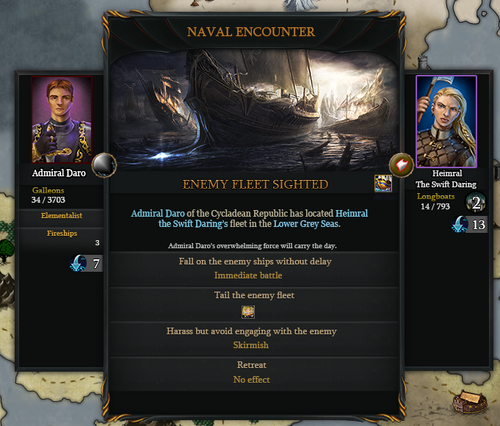Much like other strategy games Naval Conflicts plays second fiddle to Land Based warfare, but that's not to say that navies are unnecessary. On the contrary naval battles, manoeuvres, and exploration are key elements of the game and ignoring them is one of the many ways to ensure your eventual defeat. Naval conflict in TWS emphasizes preparation and strategic planning over tactical choices even more so than land battles.
The primary component of naval conflict is "ships" which come in a variety of types. Wood is required to build and maintain ships and commanders. Ships take quite a long time to build and repair slowly, once again "slowing down" the speed at which conflict on the sea occurs. However, unlike land battles naval battles are instantaneous - but in order to do battle fleets must "search out" the enemy fleet inside the contested naval zone, often giving the enemy fleet time to slip past into an adjacent zone or port.
Ships at sea can blockade any ports in their naval zone by creating a blockade, as in the picture shown on the left. The typical circular action icon is replaced by glowing red anchors, and all affected ports glow red indicating they are blockaded. Blockades require a certain amount of ships to be effective and render the fleet vulnerable to attacks by enemy fleets.
Viking Longships happily raiding (notice the same raid icon as used on land) while republican galleons search for them. Unlike land-based challenges the action of seeking out an enemy fleet is not deterministic and accruing over time, instead the chance to find the ship increases based on a variety of factors from admiral skills, ship manoeuvrability, the enemy fleets current action, and the type of naval zone.
Raiding by sea is a common tribal action and inflicts a penalty on ALL POIs with ports on that naval zone and accruing glory for the raider. The accrued raiding modifier over time gives a bonus if the sea-based raider decides to launch a land-based raid making some of the more difficult raids like storming a vault or kidnapping an individual much more obtainable. This bonus is lost if the fleet moves off that naval zone.
Once a fleet has been found (or decides to battle) you will face (if you are commanding one of the fleets) the "Fleet Found" event. Much like a challenge you will have options depending on any elite units (there are much, much fewer of these for navies) and traits possessed. Many of these will give you a penalty to your initiative but come with powerful trade offs.
Initiative serves a very important purpose in naval battles, in general the force with superior initiative is given X rounds (the difference) to inflict skirmish damage representing the time it takes for the enemy ships to close. At the end of that time the ships will clash forcing combat between their marines. The number of marines is listed to the right of the number of ships on each side. Apart from initiative each ship type has base stats for skirmish, manoeuvrability, and force which will determine how much damage they inflict or how successful they are at engaging or disengaging from enemy ships. Once the ships are engaged marines will fight one another until surrender or the ship sinks or is captured.
There are a few things to note in this screenshot. The icon on the "Enemy Fleet Sighted" tells what the type of Naval Zone is - in this case it is in shallow water which favours the Longships, though not enough to give them the benefit but perhaps enough to let them skirmish and escape with few casualties. The blue arrow icon is Initiative which displays the bottom of all possible actions as its value will change based on selections. At the bottom of each fleet you would see any artifacts that could be activated, just like in a challenge. The hero icon (same as in most screens) will appear next to the boat types with the number of heroes. Heroes add special actions to naval combat and can trigger opportunities. Also note that if you have multiple types of ships it will push the actions down one row and any more than 2 will produce a scrollbar.



